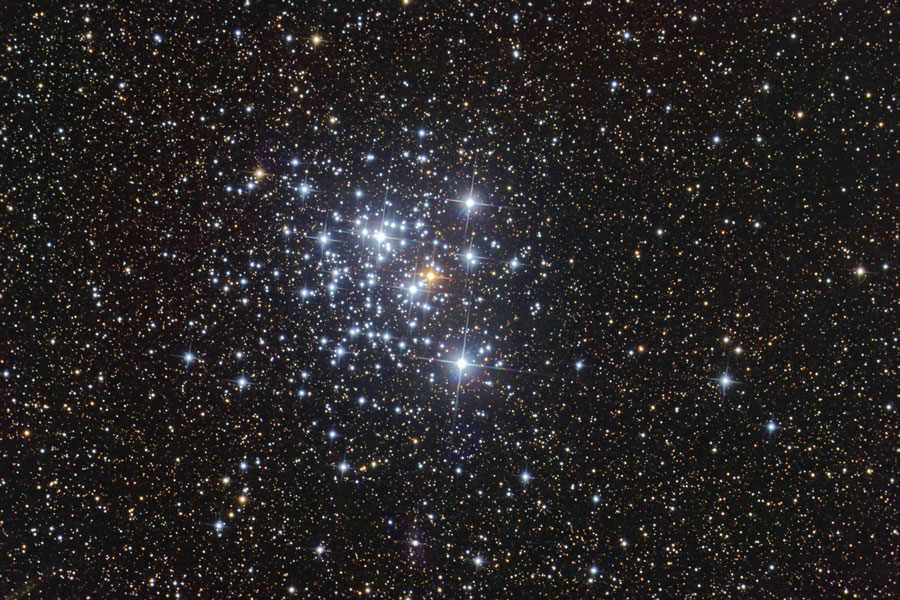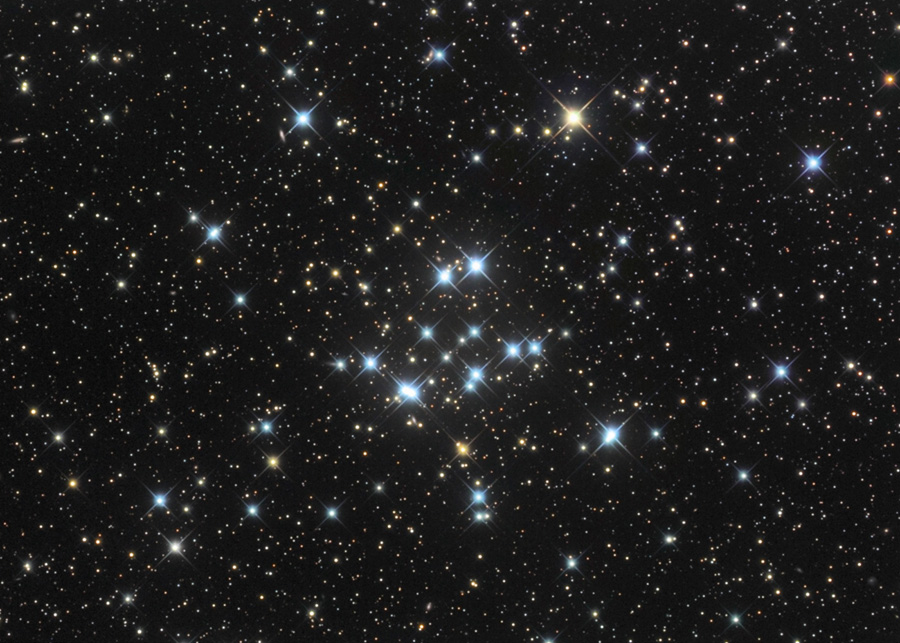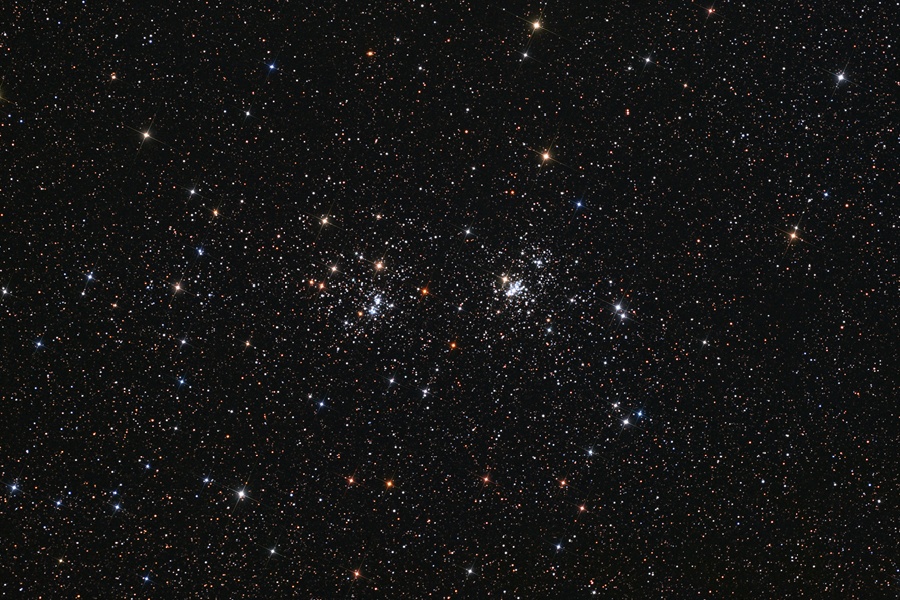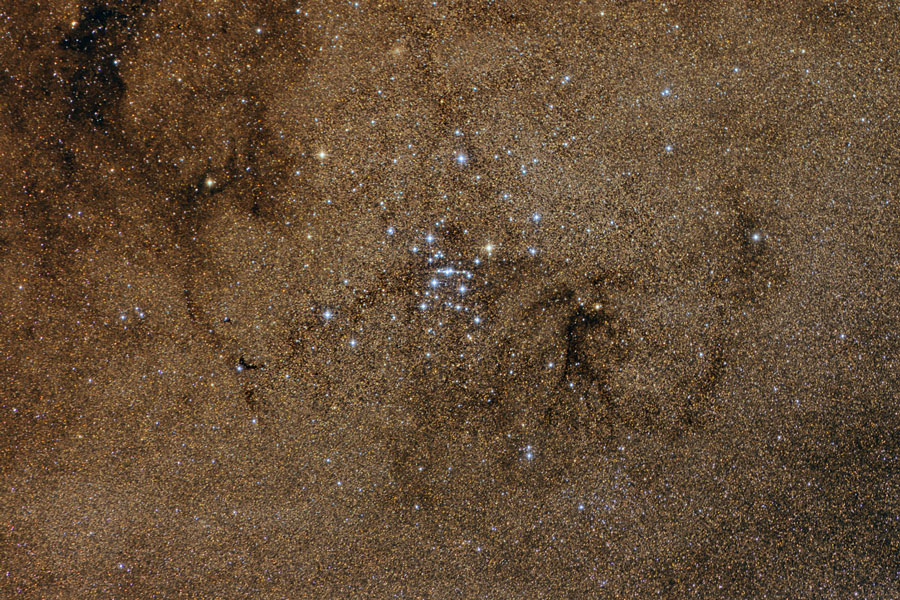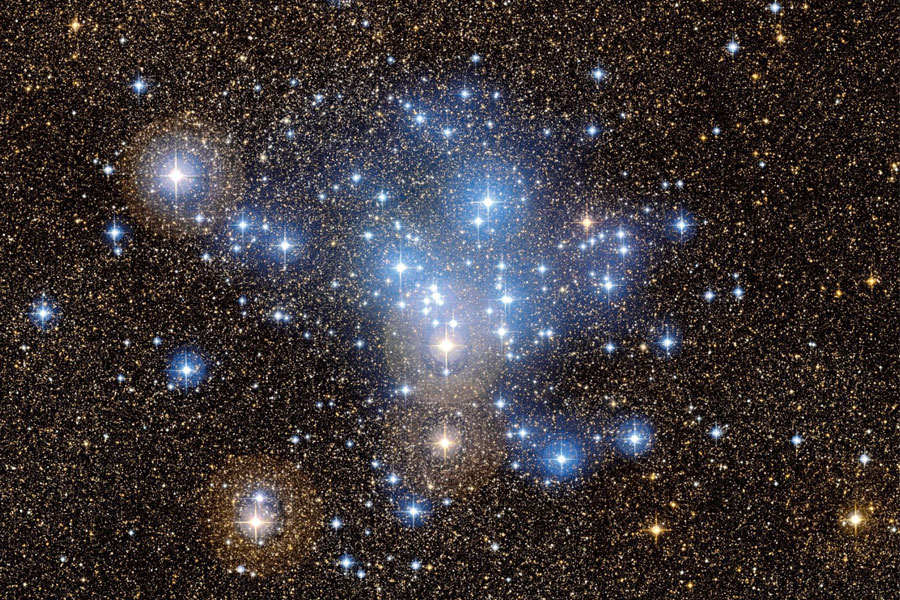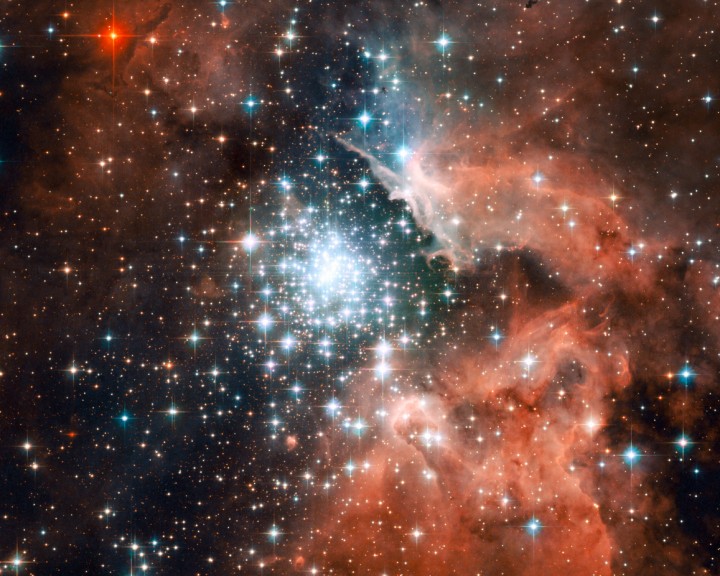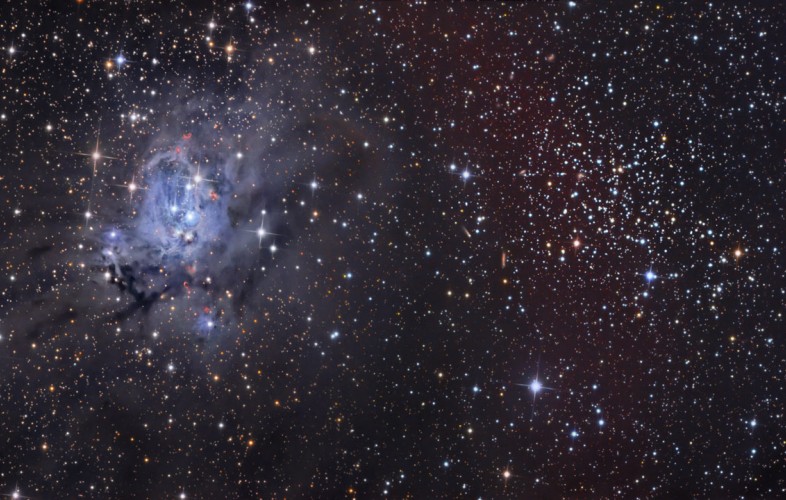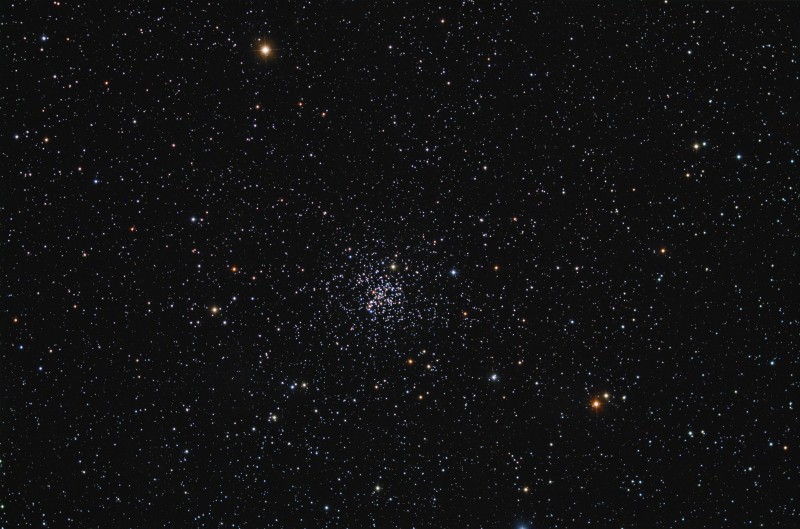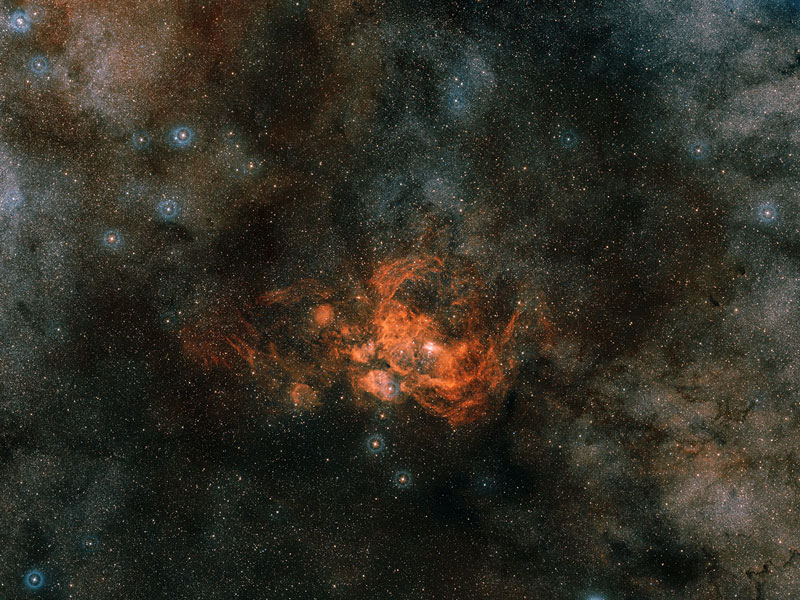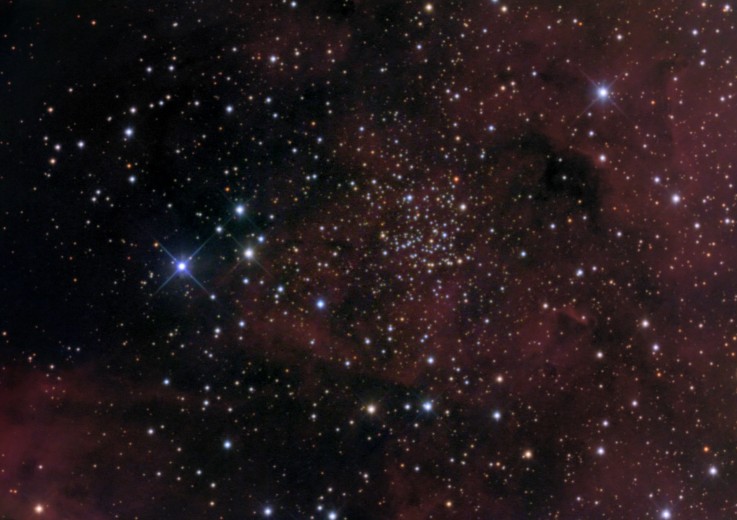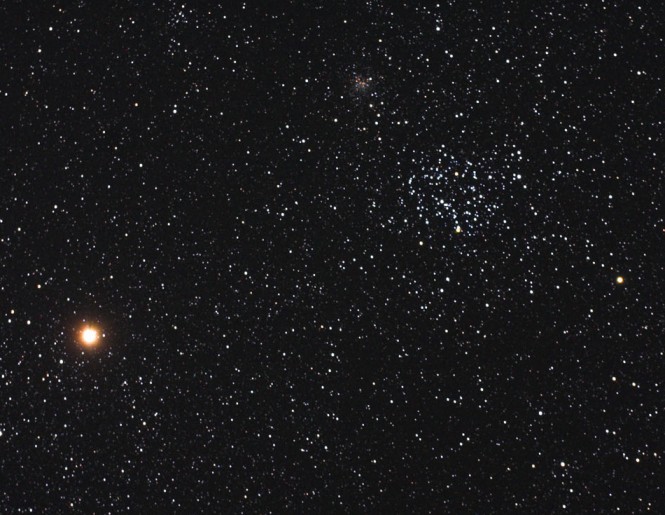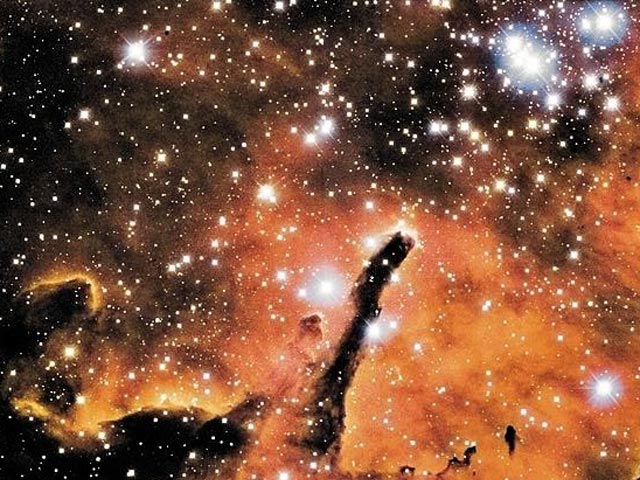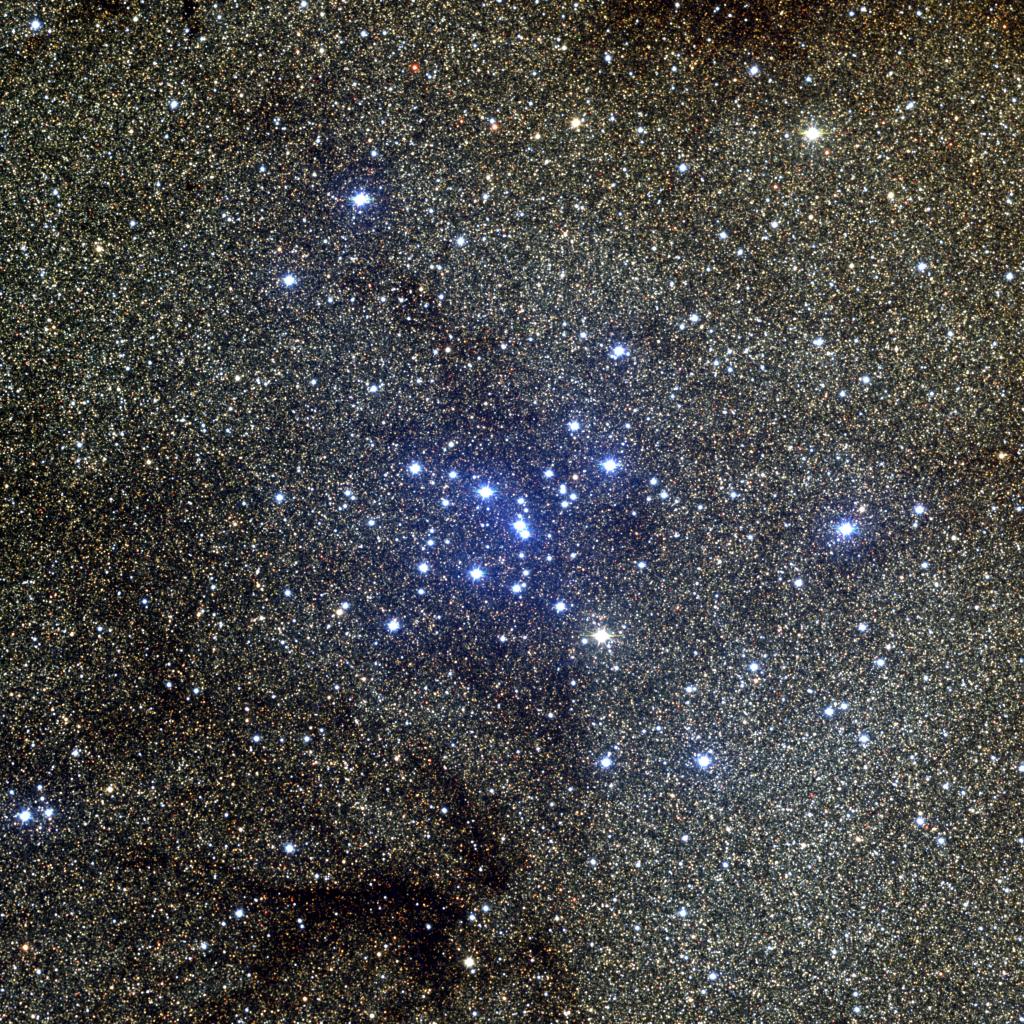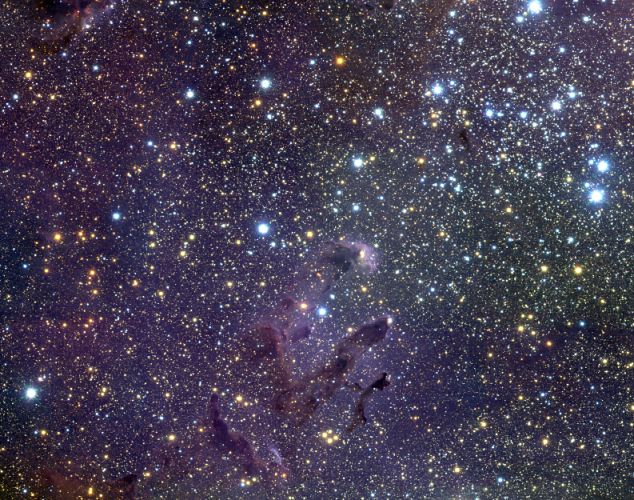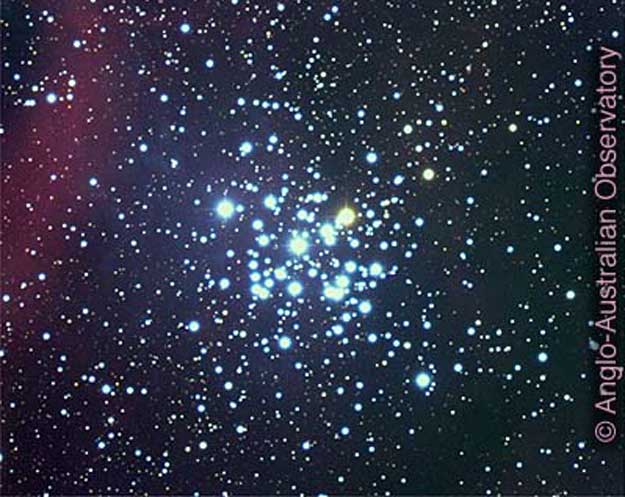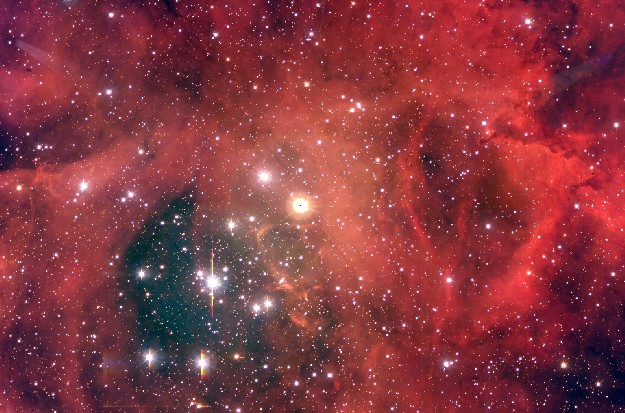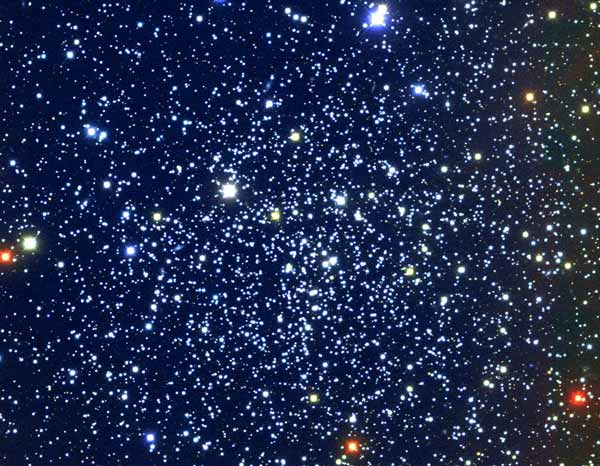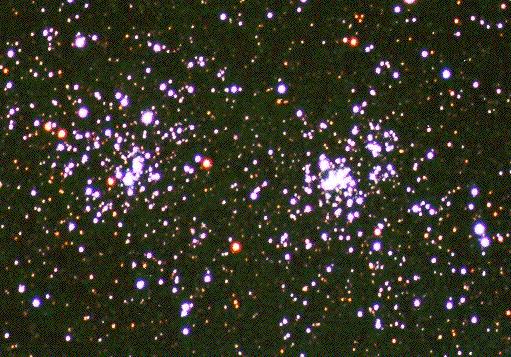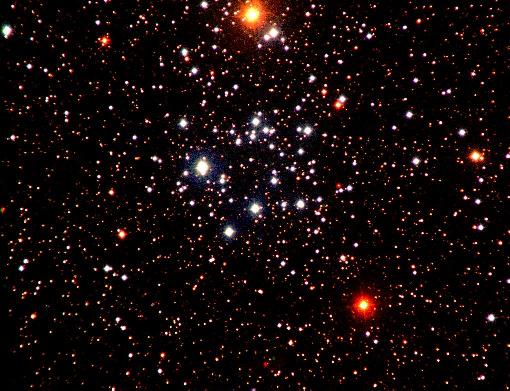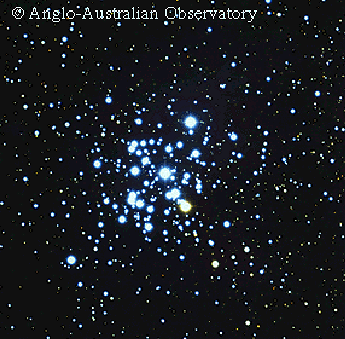Open Star Clusters
All titles are clickable and link to the original APOD page; click on an image for a larger view of it.
2010 August 17 The great variety of star colors in this open cluster underlies its name: The Jewel Box. One of the bright central stars is a red supergiant, in contrast to the many blue stars that surround it. The cluster, also known as Kappa Crucis contains just over 100 stars, and is about 10 million years old. Open clusters are younger, contain few stars, and contain a much higher fraction of blue stars than do globular clusters. This Jewel Box lies about 6,400 light-years away, so the light that we see today was emitted from the cluster before even the Great Pyramids in Egypt were built. The Jewel Box, pictured above, spans about 20 light-years, and can be seen with binoculars towards the southern constellation of the cross (Crux).
2010 February 11 This pretty, open cluster of stars, M34, is about the size of the Full Moon on the sky. Easy to appreciate in small telescopes, it lies some 1,800 light-years away in the constellation Perseus. At that distance, M34 physically spans about 15 light-years. Formed at the same time from the same cloud of dust and gas, all the stars of M34 are about 200 million years young. But like any open star cluster orbiting in the plane of our galaxy, M34 will eventually disperse as it experiences gravitational tides and encounters with the Milky Way's interstellar clouds and other stars. Over four billion years ago, our own Sun was likely formed in a similar open star cluster.
2009 December 4 A lovely starfield in the heroic northern constellation Perseus holds this famous pair of open or galactic star clusters, h and Chi Perseii. Also cataloged as NGC 869 (right) and NGC 884, both clusters are about 7,000 light-years away and contain stars much younger and hotter than the Sun. Separated by only a few hundred light-years, the clusters' ages based on their individual stars are similar - evidence that they were likely a product of the same star-forming region. Always a rewarding sight in binoculars, the Double Cluster is even visible to the unaided eye from dark locations. Star colors (and spikes) are enhanced in this beautiful, wide field, telescopic image.
2009 November 8 M7 is one of the most prominent open clusters of stars on the sky. The cluster, dominated by bright blue stars, can be seen with the naked eye in a dark sky in the tail of the constellation of the Scorpion (Scorpius). M7 contains about 100 stars in total, is about 200 million years old, spans 25 light-years across, and lies about 1000 light-years away. The above deep exposure was taken last month over several nights from Yalbraith, NSW, Australia. The M7 star cluster has been known since ancient times, being noted by Ptolemy in the year 130 AD. Also visible are a dark dust cloud and literally millions of unrelated stars towards the Galactic center.
2009 October 30 To the eye, this cosmic composition nicely balances the Bubble Nebula at the upper right with open star cluster M52. The pair would be lopsided on other scales, though. Embedded in a complex of interstellar dust and gas and blown by the winds from a single, massive O-type star, the Bubble Nebula (aka NGC 7635) is a mere 10 light-years wide. On the other hand, M52 is a rich open cluster of around a thousand stars. The cluster is about 25 light-years across. Seen toward the northern boundary of Cassiopeia, distance estimates for the Bubble Nebula and associated cloud complex are around 11,000 light-years, while star cluster M52 lies nearly 5,000 light-years away.
2009 August 31
2008 December 9 Perhaps the most famous star cluster on the sky, the Pleiades can be seen without binoculars from even the depths of a light-polluted city. Also known as the Seven Sisters and M45, the Pleiades is one of the brightest and closest open clusters. The Pleiades contains over 3,000 stars, is about 400 light years away, and only 13 light years across. A prominent telescope and car company has borrowed the star cluster's name. Quite evident in the above photograph are the blue reflection nebulae that surround the brighter cluster stars. Low mass, faint, brown dwarfs have also been found in the Pleiades.
2007 October 5
2007 September 13 This alluring telescopic image looks toward the constellation Cepheus and an intriguing visual pairing of dusty reflection nebula NGC 7129 (left) and open star cluster NGC 7142. The two appear separated by only half a degree on the sky, but they actually lie at quite different distances. In the foreground, dusty nebula NGC 7129 is about 3,000 light-years distant, while open cluster NGC 7142 is likely over 6,000 light-years away. In fact, the pervasive and clumpy foreground dust clouds in this region redden the light from NGC 7142, complicating astronomical studies of the cluster. Still, NGC 7142 is thought to be an older open star cluster, while the bright stars embedded in NGC 7129 are perhaps a million years young. The telltale reddish crescent shapes around NGC 7129 are associated with energetic jets streaming away from newborn stars. Surprisingly, despite the dust, far off background galaxies can be seen in the colorful cosmic vista.
2007 August 9 Gathered at the center of this sharp skyview are the stars of Messier 67, one of the oldest known open star clusters. In fact, though open star clusters are usually much younger, the stars of M67 are likely around 4 billion years old, about the same age and with about the same elemental abundances as the Sun. Open clusters are almost always younger because they are dispersed over time as they encounter other stars, interstellar clouds, and experience gravitational tides while orbiting the center of our galaxy. Still, M67 contains over 500 stars or so and lies some 2,800 light-years away in the constellation Cancer. At that estimated distance, M67 would be about 12 light-years across.
2007 April 13 Hurtling through a cosmic dust cloud a mere 400 light-years away, the lovely Pleiades or Seven Sisters star cluster is well-known in astronomical images for its striking blue reflection nebulae. At visible wavelengths, the starlight is scattered and reflected by the dust, but in this portrait in infrared light by the Spitzer Space Telescope, the dust itself glows. The false color image spans about 1 degree or seven light-years at the distance of the Pleiades, with the densest regions of the dust cloud shown in yellow and red hues. Exploring this young, nearby cluster, the Spitzer data have revealed many cool, low mass stars, brown dwarfs or failed stars, and possible planetary debris disks. Want to see the Pleiades tonight? Look near Venus, the brilliant evening star in the west just after sunset.
2006 December 20
2006 October 21 Clyde Tombaugh discovered planet Pluto in 1930 while surveying the skies with the 13-inch Lawrence Lowell Telescope. But the skilled and careful astronomer also went on to discover star clusters, comets, asteroids, and clusters of galaxies. For example, pictured is galactic or open star cluster Tombaugh 4 in the northern constellation Cassiopeia. Published in 1941, Tombaugh's description, based on his photographic images from the Lowell 13-inch, indicates the cluster is small and faint, and comprised of about 30 stars. Using the apparent brightness of the cluster stars he estimated the distance to be 20 to 30 thousand light-years, making Tombaugh 4 over 10 light-years in diameter. This deep color image, made with a modern ccd camera and another 13-inch telescope, includes the region's foreground stars and faint nebulosities.
2006 April 19 This evening's skyscape includes a view similar to this one, recorded in western skies on April 16 - an orange-hued planet Mars wandering near rich open star cluster M35. Also notable is fainter star cluster NGC 2158, just above and left of M35. The grouping appears near the "foot stars" of the constellation Gemini, but of course Mars is in the foreground, just over 14 light-minutes from planet Earth. The hundreds of stars in cluster M35 are more like 3,000 light-years distant. NGC 2158 is farther still, about 16,000 light-years away and is much more compact than M35. The color image shows off the contrast between hot blue stars and cooler yellowish stars within the confines of M35. But the stars of NGC 2158 are much older, and that cluster's light is definitely dominated by the orange glow of cool giant stars, making an interesting visual comparison to ruddy-colored Mars.
2006 January 9 Perhaps the most famous star cluster on the sky, the Pleiades can be seen without binoculars from even the depths of a light-polluted city. Also known as the Seven Sisters and M45, the Pleiades is one of the brightest and closest open clusters. The Pleiades contains over 3000 stars, is about 400 light years away, and only 13 light years across. Quite evident in the above photograph are the blue reflection nebulae that surround the brighter cluster stars. Low mass, faint, brown dwarfs have also been found in the Pleiades. (Editors' note: The prominent diffraction spikes are caused by the telescope itself and may be either distracting or provide aesthetic enhancement, depending on your point of view.)
2005 August 4 Galactic or open star clusters are relatively young swarms of bright stars born together near the plane of our Milky Way Galaxy. Separated by about a degree on the sky, two nice examples are M46 (upper left) 5,400 light-years in the distance and M47 (lower right) only 1,600 light-years away toward the nautical constellation Puppis. Around 300 million years young M46 contains a few hundred stars in a region about 30 light-years across. Aged 80 million years, M47 is a smaller but looser cluster of about 50 stars spanning 10 light-years. But this portrait of stellar youth also contains an ancient interloper. The small, colorful patch of glowing gas in M46 is actually the planetary nebula NGC 2438 - the final phase in the life of a sun-like star billions of years old. NGC 2438 is estimated to be only 3,000 light-years distant and likely represents a foreground object, only by chance appearing along our line of sight to youthful M46.
2005 April 6 M7 is one of the most prominent open clusters of stars on the sky. The cluster, dominated by bright blue stars, can be seen with the naked eye in a dark sky in the tail of the constellation of Scorpius. M7 contains about 100 stars in total, is about 200 million years old, spans 25 light-years across, and lies about 1000 light-years away. This color picture was taken recently at the Kitt Peak National Observatory in Arizona, USA as part of the Advanced Observers Program. The M7 star cluster has been known since ancient times, being noted by Ptolemy in the year 130 AD. Also visible is a dark dust cloud near the bottom of the frame, and literally millions of unrelated stars towards the Galactic center.
2004 October 6 How did this unusually large nebula form? One of the largest nebulas yet detected is actually a complex ring of emission nebulas connected by glowing filaments. The unusual network, known as N11, spans over 1000 light years and is a prominent structure of the Large Magellanic Cloud, the largest satellite galaxy of our Milky Way Galaxy. In the center of the above image is open star cluster LH9, also known as NGC 1760, composed of about 50 bright blue stars that emit radiation that has eroded a hole in their surroundings. A leading hypothesis for the formation of N11 is shells of successive generations of stars being formed further out from the center. The bright region just above center is N11B, an explosive domain where stars are being formed even today.
2004 October 4 Star cluster NGC 6823 is ready for its close-up. The center of the open cluster, visible on the upper right, formed only about two million years ago and is dominated in brightness by a host of bright young blue stars. Outer parts of the cluster, visible above in the image center as the stars and pillars of emission nebula NGC 6820, contain even younger stars. The huge pillars of gas and dust likely get their elongated shape by erosion from hot radiation emitted from the brightest cluster stars. Striking dark globules of gas and dust are also visible across the bottom of this image by the 25 year old Canada France Hawaii Telescope. Open star cluster NGC 6823 spans about 50 light years and lies about 6000 light years away toward the constellation of Vulpecula (The Fox).
2004 March 31 Lying just at the limit of human perception is a picturesque starfield containing one of the larger open clusters on the northern sky. Spanning an angle larger than the Moon, M39's relatively few stars lie only about 800 light years distant toward the constellation of Cygnus. The above picture of M39 is a mosaic of 33 images taken by the WIYN telescope on Kitt Peak in Arizona, USA. The stars in M39 are all about 300 million years old, much younger than the 5000 million years of our Sun. Open clusters, also called galactic clusters, contain fewer and younger stars than globular clusters. Also unlike globular clusters, open clusters are generally confined to the plane of our Galaxy.
2004 February 22
2002 May 5
2000 April 5 M7 is one of the most prominent open clusters of stars on the sky. The cluster, dominated by bright blue stars, can be seen with the naked eye in a dark sky in the tail of the constellation of Scorpius. M7 contains about 100 stars in total, is about 200 million years old, spans 25 light-years across, and lies about 1000 light-years away. This color picture was taken in 1995 at the Burrell-Schmidt Telescope at Kitt Peak National Observatory in Arizona. The M7 star cluster has been known since ancient times, being noted by Ptolemy in the year 130 AD. Also visible is a dark dust cloud near the bottom of the frame, and literally millions of unrelated stars towards the Galactic center.
2003 January 22 Many stars like our Sun were formed in open clusters. The above pictured open cluster, M11, contains thousands of stars and is just over five thousand light years distant. The stars in this cluster all formed together about 250 million years ago. The bright young stars in M11 appear blue. Open clusters, also called galactic clusters, contain fewer and younger stars than globular clusters. Also unlike globular clusters, open clusters are generally confined to the plane of our Galaxy. M11 is visible with binoculars towards the constellation of Scutum.
2003 January 7 Open cluster M38 can be seen with binoculars toward the constellation of Auriga. M38 is considered an intermediately rich open cluster of stars, each of which is about 200 million years old. Located in the disk of our Milky Way galaxy, M38 is still young enough to house many bright blue stars, although it's brightest star is a yellow giant shining 900 times brighter than our Sun. The cluster spans roughly 25 light-years and lies about 4000 light-years away. M38, pictured above, is found only about 2.5 degrees northwest of open cluster M36. Loosely bound by gravity, open clusters spread out over time as they orbit the galactic center and their member stars slowly escape.
2002 January 3 The Hubble Space Telescope's 1995 image of pillars of dust and gas, light-years long, within the Eagle Nebula (M16) was sensational. The three prominent pillars in that close-up visible light picture also appear below center in this wide-field mosaic along with massive, bright, young stars of cluster NGC 6611 (upper right), whose winds and radiation are shaping the dusty pillars. Made in near infrared light with the European Southern Observatory's 8.2-meter Antu telescope, this wide-field image makes the pillars seem more transparent, as the longer wavelengths partially penetrate the obscuring dust. While the Hubble image showed the pillars' startling surface details - over 70 opaque, finger-shaped lumps of material dubbed evaporating gaseous globules or EGGs, the near infrared view has allowed astronomers to peer inside. Comparing the two views reveals that nearly a dozen of the EGGs do indeed have stars embedded near their tips. More stars within EGGs may be detected if longer wavelength observations of the region are made. But which came first, the stars or the EGGs?
2001 September 9 Hot blue stars shine brightly in this beautiful, recently formed galactic or "open" star cluster. Open cluster NGC 3293 is located in the constellation Carina, lies at a distance of about 8000 light years, and has a particularly high abundance of these young bright stars. A study of NGC 3293 implies that the blue stars are only about 6 million years old, whereas the cluster's dimmer, redder stars appear to be about 20 million years old. If true, star formation in this open cluster took at least 15 million years. Even this amount of time is short, however, when compared with the billions of years stars like our Sun live, and the over-ten billion year lifetimes of many galaxies and our universe. NGC 3293 appears just in front of a dense dust lane emanating from the Carina Nebula.
2001 February 7 Bright blue stars highlight the open cluster known as M103. The gas clouds from which these stars condensed has long dispersed. Of the stars that were formed, the brightest, bluest, and most massive have already used up their nuclear fuel and self-destructed in supernova explosions. A 20 million-year age for M103 was estimated by finding the brightest main-sequence stars that still survive and theoretically computing their lifetimes. In fact, a formerly blue star has recently evolved off the main sequence and is visible above as the red giant star near the cluster center. In general, yellow stars like our Sun are usually less bright and hence less prominent in open clusters than their massive blue cousins. Light takes about 14 years to cross M103. Although visible with binoculars toward the constellation of Cassiopeia, M103's great distance of 8000 light years makes it appear four times smaller than a full moon.
2000 August 22 In the heart of the Rosette Nebula lies a bright open cluster of stars that lights up the nebula. The stars of NGC 2244 formed from the surrounding gas only four million years ago and emit light and wind that define the nebula's appearance today. High energy light from the bright young stars of NGC 2244 ionizes the surrounding hydrogen gas clouds to create the red emission nebula appearance. The hot wind of particles that streams away from the cluster stars contributes to an already complex menagerie of gas and dust filaments while slowly evacuating the cluster center. NGC 2244 measures about 50 light-years across, lies about 4500 light-years away, and is visible with binoculars towards the constellation of Monoceros.
2000 January 12 NGC 6791 is one of the oldest and largest open clusters of stars known. But how did it get so dirty? Open star clusters usually contain a few hundred stars each less than a billion years old. Open star cluster NGC 6791, however, contains thousands of stars recently measured to be about 8 billion years old. What's really confusing, though, is that the stars of NGC 6791 are relatively dirty - the minuscule amounts of heavy elements (generically called metals) are high relative to most other star clusters. Older stars are supposed to be metal poor, since metals have only been slowly accumulating in our Milky Way Galaxy. This enigma makes NGC 6791, pictured above, one of the most studied open clusters and a possible example of how stars might evolve in the centers of galaxies.
January 29, 1997 Most star clusters are singularly impressive. But open clusters NGC 869 and NGC 884 are doubly impressive. Also known as "h and chi Persei", this rare double cluster, shown above, is bright enough to be seen from a dark location without even binoculars. Although their discovery surely predates written history, the "double cluster" was notably cataloged by the Greek astronomer Hipparcos. The clusters are over 7000 light years distant toward the constellation of Perseus, but are separated by only hundreds of light years.
January 28, 1997 Many stars form in clusters. Two types of star clusters are visible in our Milky Way Galaxy: open clusters and globular clusters. Open clusters like M50, shown above, typically contain hundreds of stars, many of which are bright, young, and blue. In fact, most of the bright blue stars in the above picture belong to M50, but most of the dimmer, red stars do not. M50 lies about 3000 light-years from Earth and is about 20 light years across. Open clusters tend to have irregular shapes and are mostly found in the plane of our Galaxy.
March 29, 1998
August 23, 1996 Hot blue stars shine brightly in this beautiful, recently formed galactic or "open" star cluster. Open cluster NGC 3293 is located in the constellation Carina, lies at a distance of about 8000 light years, and has a particularly high abundance of these young bright stars. A study of NGC 3293 implies that the blue stars are only about 6 million years old, whereas the cluster's dimmer, redder stars appear to be about 20 million years old. If true, star formation in this open cluster took at least 15 million years. Even this amount of time is short, however, when compared with the billions of years stars like our Sun live, and the over-ten billion year lifetimes of many galaxies and our universe. NGC 3293 appears just in front dense dust lane emanating from the Carina Nebula.
